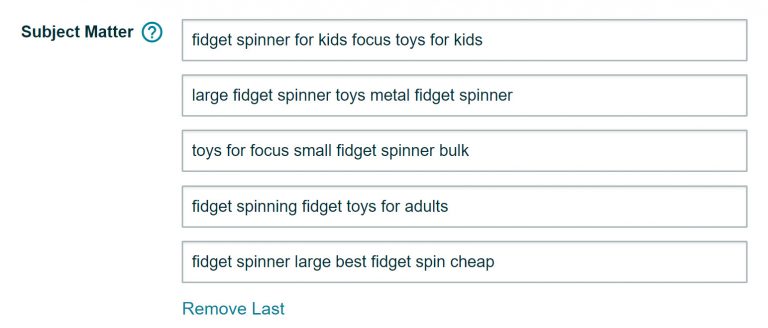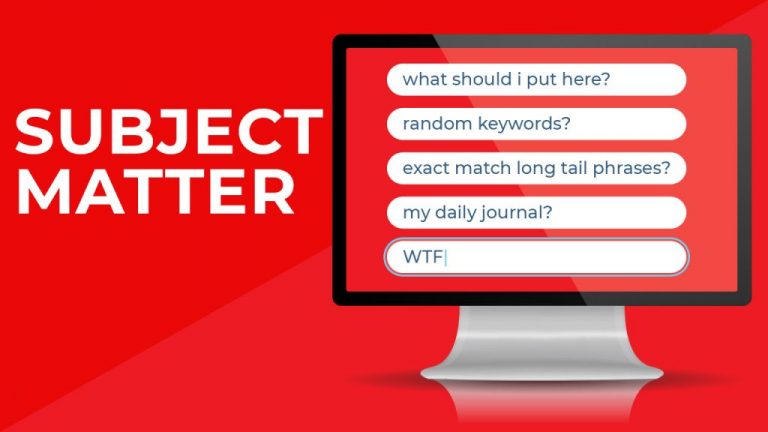Keyword optimization on Amazon is a moving target, so staying up to date with current best practices is key to staying on top of page 1.
After every major change Amazon implements, it takes a while for the new best practices to emerge. I’m here today to tell you they’ve emerged…
What are Amazon Subject Matter Fields?
The Subject Matter fields are text fields you are asked to fill out when editing your Amazon listing. They’re 5 fields of 50 characters each for a total of 250 characters, not much real estate. Their original purpose is to give Amazon a bit more context about what your product actually is.
Since Amazon’s back end search terms have been reduced to a 250 byte limit, it’s not a good strategy to rely on it for your best keywords.
Why is Subject Matter So Powerful?
Kevin King, a multi million dollar Amazon seller told me in an interview “Besides the Title, subject matter is the most powerful place to put keywords. More than bullets, description, or backend search terms.”
I have seen this backed up with data from several 7 figure sellers I know personally on some smaller scale tests, and have talked with people with access to much larger scale tests who have had similar results.
Become an Amazon Subject Matter Expert
In my experience, hacks or loopholes that go against Amazon’s best interests don’t last long or are de-incentivized.
Using the subject matter fields for your top keywords is giving Amazon exactly what they want, & that’s nearly always rewarded.
Being titled “subject matter” likely means their algorithm uses these fields to determine the proper category or provide context for what your product is. Using your top, most relevant keywords here would provide exactly that.
If the bullet points or description had more “keyword ranking juice” then sellers would be incentivized to keyword stuff the hell out of them which is NOT in Amazon’s best interest.
Obviously bullets & description are meant to explain key details & information about your product to potential buyers, not be a grammatically questionable maze of search phrases.
How to Optimize Amazon Subject Matter Fields

The above image is just an example where I made up the subject matter keywords, but this is typical. Notice how I’m using full phrases and not just individual keywords.
While Amazon does (usually) allow you to index and rank for different phrases if you index for each keyword individually, it sometimes won’t, & in many cases will not have as much “ranking juice” as the full phrase.
There are 5 subject matter keyword fields with 50 characters maximum each. Fill them out with your top 6 to 8 search phrases (long tail keywords) based on your product research. Be sure they are exact match.
Since these are your top phrases, they should also be in your title & other places in your listing (my rule is 3 times total).
If your top 2 search phrases are “yoga mat for women” & “women yoga mat” then both should be in your subject matter. However you can combine them both into “yoga mat for women yoga mat” to kill 2 birds with one stone.
Be sure not to exceed 50 characters per line & don’t be afraid to repeat keywords, remember, we’re targeting our top phrases & that almost always means 1 or 2 keywords will show up in nearly every phrase.
How Do You Identify the "Main" Search Phrases?
This is a complex subject, but there are 2 main factors that must be present for it to be one of your “main search phrases”
- It must directly explain what your product is by itself
- Choosing too broad of a keyword is a recipe for disaster. Ex. your product is a vacuum seal freezer bag and you choose “plastic bag” as a main keyword, the search results are likely dominated by plastic bags that have nothing to do with your product.
- It’s more likely people are searching for garbage bags or ziploc bags, not to mention broad keyword phrases have a low conversion rate due to the broad number of products it’s searcher may be looking for.
- It must have high search volume
- The definition of high search volume will vary drastically depending on what your product is, but relatively, it must be high. Basically, out of the search terms that meet criteria number 1, what are the highest search volume ones?
- A good way of identifying these is with Helium 10’s reverse ASIN tool Cerebro. Type in your top competitor’s ASINs to see what keywords they are ranking for & sort them by highest to lowest search volume.
You definitely have to add in some common critical thinking here because there are lots of exceptions. Certain products have very different words that can potentially describe your product and that shoppers may still search for. It’s up to you to dig deep and apply some reasoning whether a certain keyword is relevant enough to your product, but after reading this you’ll be an Amazon Subject Matter Expert so you’ll have a good enough idea.
Step by Step Amazon Subject Matter Example
- Identify your top 6-8 Amazon search phrases using reverse ASIN tools & logical reasoning
- Fill out each of your 5 subject matter fields with these phrases (50 characters max per field) in the Keywords & Description tab when editing product information
- Save your changes
- Get boosted keyword indexing & ranking for your top search phrases
Straight and simple. Are you using subject matter fields like this? Let me know by reaching out in the messenger chat window on this page.
Looking for a full guide to writing Amazon listings with keyword optimization? Check our full guide here.



